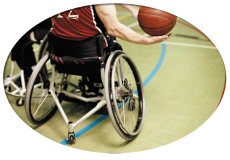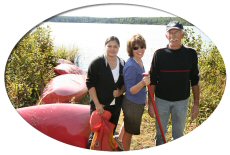


Creating Change >
Individual Level: Motivation
Finding power from within.
In the Physical Activity for All focus groups, many participants talked about the importance of motivation to becoming and remaining physically active. They identified both internal motivators (i.e., motivation comes from within and physical activity is done for enjoyment) and external motivators (motivation comes from the desire to achieve an external reward).
 Sources of Motivation
Sources of Motivation
Research identifies five sources of motivation—some of them internal, some of them external (Deci and Ryan, 2000, 2007). The experiences of the focus group participants clearly reflect these findings.
1. Intrinsic motivation: An individual chooses to be active because they enjoy it.
I’m happy when I’m exercising. It’s good for the stress. It’s relaxing for me.
New Canadian focus group participant
2. Integrated motivation: An individual chooses to be active because physical activity is consistent with personal goals.
Well, I’ve always exercised.
Older adult focus group participant
I went on a canoe trip from Fort McMurray to Fort Chip. And it just relaxed my body, my mind, and my spirit...For me, that connection—that connection to myself, the connection to the environment, the connection to the waters and the trees and the wind, just everything. It’s not just a physical activity but it has to encompass the whole of a person.
Aboriginal focus group participant from rural community
3. Identified motivation: An individual is motivated by a combination of internal and external values.
If I don’t exercise...my muscles will atrophy and I’ll wind up in a worse condition than I am, unable to do anything for myself. So that’s a big motivator.
Focus group participant with a disability
I’m scared of getting old and I don’t want to look old and I don’t want to act old. And I want to stay as healthy as I possibly can.
Older adult focus group participant from rural community
4. Introjected motivation: An individual feels proud after participating in physical activity, but embarrassed or ashamed if s/he doesn’t.
Having someone to motivate you...who always gets so excited when I turn up in her exercise class – it says something about me. But she always seems glad to see me, you know, and I always kind of feel like I’ve let down my end if I don't show up.
Older adult focus group participant from rural community
You feel obligated…say, you know, oh it’s too windy, or it’s too cold. But you know, you paid some money, you belong to this particular group, you’re committed on a weekly basis and you participate.
Older adult focus group participant
5. External motivation: An individual participates in an activity because of an external reward or payment, not necessarily because of an interest in the activity.
It's good for weight loss.
Older adult focus group participant from a rural community
Three Components of Motivation
Research also suggests that motivation consists of three components (Deci and Ryan, 2000). Once again, the experiences of the focus group participants were consistent with the research.
1. Energy (which directs the behavior)
The following participant finds the energy to exercise because she knows it will increase mental alertness.
I know when I go out for a run in the gym in the morning when I go to class, I can think about my subjects.
Aboriginal focus group participant from a rural community
I find that I’m the type of person that I’ve got to be working with someone, or doing exercise with someone—it’s more motivating than trying to do exercise at home by myself.
Older adult focus group participant
2. Direction (to avoid or do something)
When asked, “Why are you active?” the following response shows how the participant wants to avoid poor cardiovascular health and gain muscle.
I guess getting muscle and prevent[ing] yourself from getting cholesterol and heart attack. That’s about it.
Aboriginal focus group participant
3. Persistence (the quality of the motivation results in exercise persistence)
Many different things can lead a person to begin—and keep up with—physical activity. In the following example, we see that the persistence of the motivation is currently lacking. When they first purchased the treadmill or discovered the walking paths, they were active. But when the novelty wore off, she could no longer motivate herself. This individual has low motivational persistence.
I have a treadmill, I have really nice pathways to walk in my community. It’s a new district, so they have really big nice pathways. The only thing I don't have is will!”
New Canadian focus group participant
Getting Motivated: An Ecological Approach
Focus group participants identified motivational issues that affect their ability to become and remain physically active. To succeed in addressing this issue, use strategies that incorporate the various levels of an ecological model:
Want to learn more about this topic? Click here for useful online materials.
- The Individual
- The Social Environment
- The Physical Environment
- Policies and Regulations
Strategies for getting motivated
Quick links in Creating Change sectionIndividual Level Social Environment Level Physical Environment Level
|